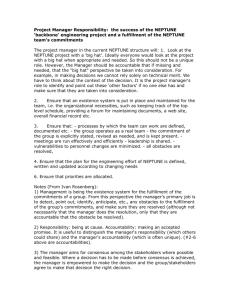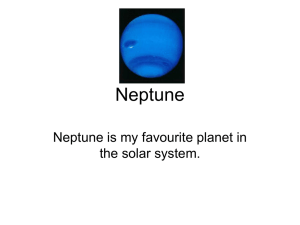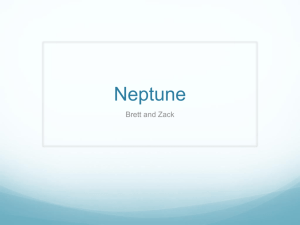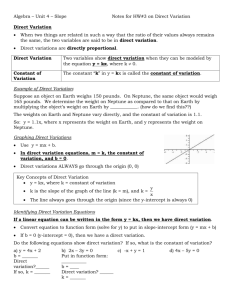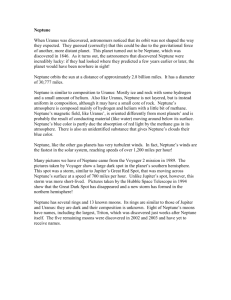Neptune
advertisement
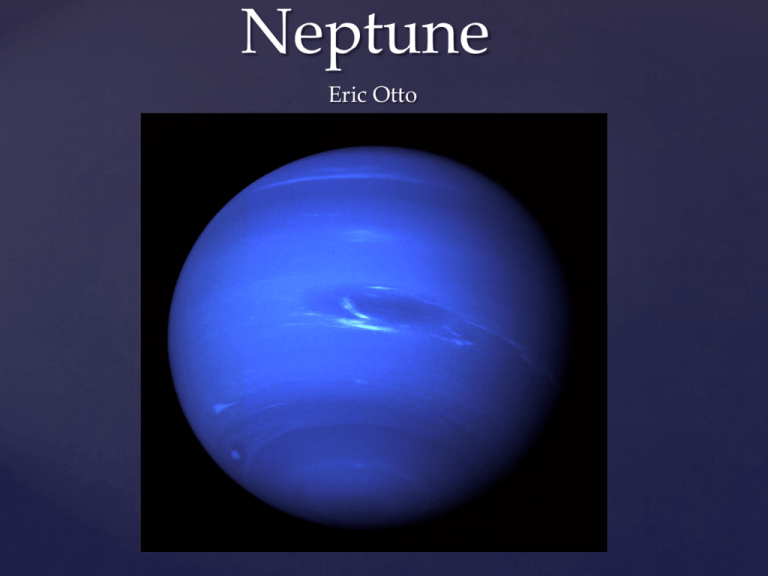
Neptune
Eric Otto
{
Neptune’s Symbol
Neptune’s Name
Roman god of seas
Poseidon
Color
Not used god
The Discovery of Neptune
Johann Gottfried Galle
Urbain Le Verrier
Heinrich Lois d’ Arrest
John Couch Adams
Uranus’s orbit
Telescope
Triton
Relative Location
Order: 8th
D. from Sun: approx. 4,460,000,000-4,540,000,000
D. from Earth: approx. 430,000,000,000
Measurements/data
Mass: about 17.2 times Earth’s size (102.4E24 kg)
Volume: approx. 62,525,703,987,421 km³
Density: 1,638 kg
Sink: no, composition too heavy
Gravity: about 1.12 times Earth’s
Orbit/Rotation
Orbit: 165 Earth years
Rotation: about 19.1 Earth hours
Atmosphere
1% Methane other
80% hydrogen, 19% helium
Thick
Temperature
Average 73 K (-328)
Tilted more than Earth (30)
Over 390 degrees colder than Florida
Extreme seasons
Neptune’s appearance
Gas giant
Windy and cold
Mantle of ammonia and methane ices
Core iron and magnesium
Size of Uranus
Dark blue
Dark storms can appear
Neptune’s Weather
Similar to most gas giants
Dark spots can form (storms)
Similar to Jupiter’s red spots
Scooter
Goes around the planet
Neptune’s Rings
Four rings
Inferred that rings are young and short lived
Disappearing rapidly
Dark
Found in 1989
The moons of Neptune
14 moons
Triton- largest and has ice on it, with a thick atmosphere, in retrograde:
1846
Nereid- third largest, distance from Neptune varies from 1,353,600 to
9,623,700 km: 1949
Naiad- smallest named moon, closest to Neptune: 1989
Thalassa- second closest to Neptune irregularly shaped: 1989
Despina- small moon near Neptune: 1989
Galatea- small moon that is close to Neptune: 1989
Larissa- non-spherical moon that is heavily cratered: 1989
Proteus- second largest moon that is dark and close to Neptune
(irregular): 1989
Halimede- retrograde: rumored to be part of Nereid: 2002
Psamathe- takes 25 years to orbit, retrograde: 2003
Sao-Kozai resonance, inclination of orbit decreases, eccentricity
increases, vice versa: 2002
Laoredeia- one of the small moons of Neptune: 2002
Neso- 48,000,000 km away, farthest moon in SS, 26.67 revolution: 2002
S/2004 N1 (unnamed) unnamed, smallest satellite: 2004
Water
All water present is ice
Mostly in gas and rings
A visit to Neptune
Freeze instantly
Too much pressure
Winds would smash you against objects
Gas giant- no true ground except core/ fall to death
Special facts
Winds can reach 2,000 km, making it fastest winds in
solar system
Causes storms (dark spots)
Dissipates in a few years
Works Cited Page
"Neptune." L Facts, Pictures and Information. N.p., n.d.
Web. 17 Dec. 2013.
<http://nineplanets.org/neptune.html>.
"Welcome to the Planets: Neptune." Welcome to the
Planets: Neptune. N.p., n.d. Web. 19 Dec. 2013.
<http://pds.jpl.nasa.gov/planets/choices/neptune1.htm
>.
"Neptune: The Other Blue Planet in Our Solar
System." Space.com. N.p., n.d. Web. 18 Dec. 2013.
<http://www.space.com/41-neptune-the-other-blueplanet-in-our-solar-system.html>.
"Solar System Exploration: Planets: Neptune:
Overview." Solar System Exploration: Planets: Neptune:
Overview. N.p., n.d. Web. 19 Dec. 2013.
<http://solarsystem.nasa.gov/planets/profile.cfm?objec
t=Neptune>.
Works Cited Page
"Neptune - EnchantedLearning.com." Neptune EnchantedLearning.com. N.p., n.d. Web. 19 Dec. 2013.
<http://www.enchantedlearning.com/subjects/astrono
my/planets/neptune/>.
"Neptune." - Windows to the Universe. N.p., n.d. Web.
19 Dec. 2013.
<http://www.windows2universe.org/neptune/neptune
.html>.
"Compare Planets." Planet Database. N.p., n.d. Web. 18
Dec. 2013. <http://planets.findthedata.org/>.
"Universe Today." Universe Today RSS. N.p., n.d. Web.
17 Dec. 2013. <http://www.universetoday.com/>.
Pictures cited
Pg. 1
http://solarsystem.nasa.gov/planets/profile.cfm?Object=Neptune
Pg. 2
http://www.clker.com/clipart-28063.html
Pg. 3 http://imythology.wikispaces.com/Neptune
Pg. 4 http://www.berlin-sciences.com/en/facts/history-of-science-inberlin/
http://www.lcsd.gov.hk/CE/Museum/Space/EducationResource/Un
iverse/framed_e/lecture/ch09/ch09.html
Pg. 5 http://en.wikipedia.org/wiki/Solar_System
Pg. 6 http://www.windows2universe.org/neptune/neptune.html
Pg. 7
https://www.windows2universe.org/comets/Kuiper_belt.ht
ml&edu=high
Pg. 8
http://www.physics.upenn.edu/nineplanets/neptune.html
Pictures cited
Pg. 9 http://factspage.blogspot.com/2011/09/how-doesthermometer-work.html
Pg. 10
http://news.nationalgeographic.com/news/2010/08/100812neptune-asteroid-trojan-dead-zone-space-science/
Pg. 11 http://www.mahjoob.com/en/forums/94123-3-saturnready-its-close-up/
http://www.jpl.nasa.gov/spaceimages/wallpaper.php?id=PI
A00049
Pg. 12
http://www.arcadiastreet.com/cgvistas/neptune_0000b.htm
Pg. 13
http://www.brown.edu/Departments/Italian_Studies/n2k/vi
sibility/Alison_Errico/Soft%20Moon/softmoon.html
http://apod.nasa.gov/apod/ap951104.html
Pictures cited
Pg. 14 http://www.wallpapersroom.com/749/Blue/Space/by_Sami_Mattila/Ice/Planet
s/Landscapes/Full/HD/Wallpaper/
Pg. 15
http://library.thinkquest.org/28327/html/universe/solar
_system/planets/neptune/surface/surface_winds.html
Pg. 16
http://www.arcadiastreet.com/cgvistas/neptune_0060.
htm

